Roasted Squash, Kale & Feta Salad with Walnut Vinaigrette: A Bright Boost for Winter Wellness
As the days grow shorter and the air turns crisp, many of us experience a subtle shift in our energy and mood. This feeling is a common indicator of Seasonal Affective Disorder (SAD), a type of depression strongly linked to the changing seasons and reduced sunlight. But what if a simple, vibrant meal could be a powerful tool in your wellness arsenal against the winter blues? We proudly present our delightful Roasted Squash, Kale & Feta Salad with Walnut Vinaigrette. This isn’t just a recipe; it’s a meticulously crafted dish designed to nourish your body and uplift your spirits, making it a cornerstone of our “Foods To Fight Seasonal Affective Disorder” series.
Developed with insights from national daytime shows like “The List,” this salad is more than just delicious. It’s brimming with ingredients celebrated for their exceptional mood-boosting properties, actively helping to alleviate symptoms of depression, anxiety, and general malaise that often accompany the colder months. Get ready to discover how a simple blend of wholesome ingredients can make a significant difference in your daily well-being.
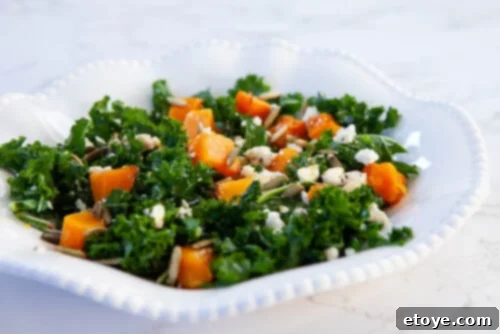
Nourish Your Mind: How This Salad Combats Seasonal Affective Disorder
Addressing Seasonal Affective Disorder often requires a holistic approach, and nutrition stands out as a vital component. This Roasted Squash, Kale & Feta Salad is a powerhouse of beneficial ingredients, each playing a critical role in supporting brain health and promoting mental well-being. Let’s explore the science-backed reasons why this dish can contribute to a brighter, more balanced mood:
Omega-3 Fatty Acids: Essential for Brain Function and Mood Stability
A cornerstone of this salad’s mood-enhancing capabilities lies in its rich supply of Omega-3 fatty acids. Key ingredients such as the tender Roasted Butternut Squash, crunchy Roasted Pumpkin Seeds (Pepitas), and the flavorful Walnut Vinaigrette are exceptional sources of these essential fats. Omega-3s are widely recognized for their potent anti-inflammatory effects and their indispensable role in maintaining optimal brain function. Numerous studies underscore their benefits; for instance, research from the University of Pittsburgh highlighted a strong correlation between a higher dietary intake of omega-3 fatty acids and a significantly reduced risk of experiencing depressive symptoms.
These crucial fatty acids contribute to the structural integrity and fluidity of cell membranes, particularly within the brain. This allows for more efficient communication between neurons, supporting overall cognitive performance, memory, and emotional regulation. Beyond their Omega-3 content, butternut squash provides a wealth of vitamins A and C, vital for a robust immune system, which can often be challenged during the colder months. Pumpkin seeds offer more than just healthy fats; they are also a source of tryptophan, an amino acid that acts as a precursor to serotonin, a key neurotransmitter responsible for feelings of well-being and happiness. Walnuts, a central component of our vinaigrette, not only deliver Omega-3s but also provide a potent blend of antioxidants and other neuroprotective compounds that shield brain cells from oxidative damage.
Kale: The Superfood Powerhouse for Neurotransmitter Production
While Kale has long been celebrated as a nutritional powerhouse, its specific benefits for mental health are particularly compelling. Ranked among the most nutrient-dense foods on the planet, kale supplies an impressive array of vitamins and minerals often deficient in modern diets. Most notably, it is an outstanding source of Vitamin B9, commonly known as folate. Folate plays a non-negotiable role in the synthesis of vital neurotransmitters such as dopamine and serotonin – chemicals that are fundamental for mood regulation, pleasure, and motivation. A deficiency in folate has been demonstrably linked to an increased risk of depressive symptoms, underscoring kale’s importance, especially for individuals navigating Seasonal Affective Disorder.
Furthermore, kale is abundantly rich in vitamins K, A, and C, alongside a diverse spectrum of antioxidants. These compounds work synergistically to reduce oxidative stress and chronic inflammation within the body, factors increasingly implicated in the development and persistence of various mood disorders. Its substantial fiber content also contributes to a healthy gut microbiome, which recent scientific advancements have shown to have a profound and direct connection to brain health and emotional well-being. Incorporating kale into your diet is a delicious and effective strategy to support both your physical and mental vitality.
Crafting Your Mood-Boosting Meal: The Essential Ingredients
Preparing this exceptionally delicious and health-promoting salad begins with assembling the freshest and highest-quality ingredients. Each component has been carefully selected for its nutritional value and its contribution to the salad’s vibrant flavors and textures. Here’s a comprehensive list of what you’ll need to bring this invigorating dish to life:
For the Hearty Roasted Squash, Kale & Feta Salad:
- 4 cups butternut squash, peeled, deseeded, and precisely cut into 1-inch cubes
- 2 tablespoons extra virgin olive oil, for roasting the squash
- 2 bunches of fresh kale, with leaves thoroughly washed, dried, and coarsely chopped (discarding the tough stems)
- 1/2 teaspoon kosher or sea salt, for seasoning and massaging the kale
- 4 ounces crumbled Feta cheese, for a salty, creamy counterpoint
- 1/4 cup roasted pumpkin seeds (pepitas), for a delightful crunch and added nutrients
For the Bright and Tangy Citrus Walnut Vinaigrette:
- 2 tablespoons sherry vinegar, offering a subtle nutty and sweet flavor base
- 1 medium-sized orange, both zested finely and freshly juiced, for a burst of citrus brightness
- 1 tablespoon honey, to balance the tanginess with natural sweetness
- 1 tablespoon grainy mustard (such as Dijon or whole grain), for depth and emulsification
- 1/4 cup extra virgin olive oil, forming the primary oil base
- 2 tablespoons walnut oil, adding a distinct nutty flavor and Omega-3s
- 2 tablespoons water, to achieve the desired consistency
- ½ teaspoon kosher or sea salt, to enhance all flavors
- Freshly ground black pepper, to taste, for a subtle spicy kick
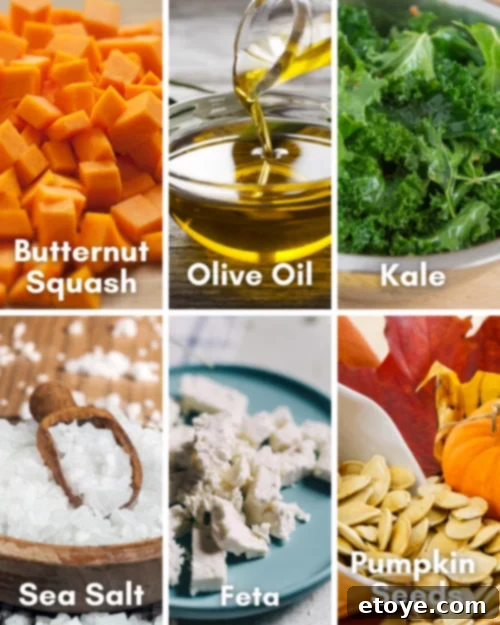
Simple Steps to a Stellar Salad: Your Easy Preparation Guide
This recipe is crafted for ease and efficiency, allowing you to create a gourmet-quality, health-packed meal without requiring extensive culinary expertise. Follow these straightforward steps to prepare your nourishing Roasted Squash, Kale & Feta Salad, and enjoy the process of bringing a delicious, mood-boosting dish to your table:
Roast the Butternut Squash to Perfection: Begin by preheating your oven to a robust 450°F (232°C). In a spacious mixing bowl, gently toss the precisely cut 1-inch butternut squash cubes with the 2 tablespoons of extra virgin olive oil. Ensure each cube is lightly and evenly coated. Spread the oiled squash in a single layer across a large baking sheet, ideally lined with parchment paper to prevent sticking and aid in easy cleanup. Roast the squash for approximately 20 minutes, or until the cubes become wonderfully tender, acquire a beautiful golden-brown hue, and develop a slightly caramelized exterior. This roasting process intensifies the squash’s natural sweetness, adding a delightful depth of flavor to your salad.
Prepare and Massage the Kale: While the butternut squash is gracefully roasting, turn your attention to the kale. Place the washed and chopped kale leaves into a large bowl. Sprinkle them generously with ½ teaspoon of kosher or sea salt. Now comes a crucial step for optimal texture: using your clean hands, gently but firmly “massage” the salt into the kale leaves for about 2 to 3 minutes. This transformative technique breaks down the kale’s naturally tough fibers, rendering it remarkably more tender, palatable, and significantly easier to digest. You’ll observe the kale changing from a rigid, deep green to a brighter, silkier, and wonderfully soft texture. Once adequately massaged, incorporate the warm roasted squash, the crumbled feta cheese, and the roasted pumpkin seeds into the bowl with the softened kale.
Whisk Together the Bright Vinaigrette: It’s time to create the exquisite citrus walnut vinaigrette. Combine all the dressing ingredients – including the sherry vinegar, the aromatic orange zest, fresh orange juice, sweet honey, a dollop of grainy mustard, extra virgin olive oil, rich walnut oil, water, and the remaining ½ teaspoon of kosher or sea salt (along with freshly ground black pepper to taste) – into a mason jar. Ensure the jar has a tight-fitting lid. Secure the lid firmly and shake the jar vigorously for approximately 30 seconds to a full minute, until all the ingredients are thoroughly combined and have emulsified into a smooth, cohesive dressing. As an alternative, you can whisk them together in a small bowl until evenly blended.
Assemble and Serve Your Masterpiece: With all components prepared, gently pour the freshly made Citrus Walnut Vinaigrette over the salad ingredients nestled in the large bowl. Toss the salad delicately to ensure that all the roasted squash, tender kale, crumbled feta, and crunchy pumpkin seeds are beautifully coated with the flavorful dressing. Serve this vibrant salad immediately to enjoy its peak freshness and textural contrast. Should you have any delightful leftovers, store them in an airtight container in the refrigerator for up to 2 days, though the salad is truly best savored fresh.
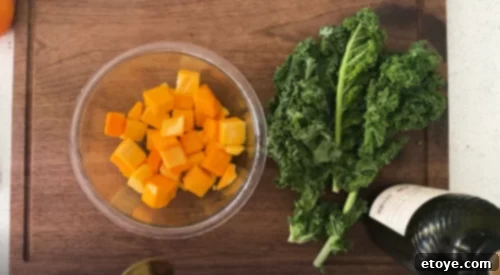

Frequently Asked Questions About Seasonal Affective Disorder & This Recipe
To further empower you in your journey towards better seasonal wellness, here are some commonly asked questions regarding Seasonal Affective Disorder and practical tips related to this recipe:
What Exactly is Seasonal Affective Disorder (SAD)?
Seasonal Affective Disorder (SAD) is a specific type of depression characterized by a recurrent seasonal pattern, typically emerging during the fall and winter months and naturally resolving as spring and summer arrive. This cyclical mood disorder is primarily attributed to decreased exposure to natural sunlight during the shorter, darker days. SAD affects a substantial segment of the population; it is estimated that approximately 20% of Americans experience SAD, with a notably higher prevalence among women, who account for roughly 75% of reported cases.
The symptoms of SAD can significantly impact daily life and typically include persistent fatigue, a pervasive feeling of “brain fog” or pronounced difficulty concentrating, noticeable changes in sleep patterns (often characterized by an increased desire to oversleep), heightened anxiety levels, pervasive feelings of sadness, hopelessness, or irritability, and frequently, weight gain stemming from increased cravings for carbohydrate-rich comfort foods. While established treatments like light therapy are highly effective, integrating mindful dietary choices can powerfully influence the severity and overall management of SAD symptoms. Prioritizing nutrient-dense foods that bolster neurotransmitter production and mitigate inflammation, such as the carefully selected ingredients in this salad, represents a proactive and delicious strategy towards fostering improved emotional well-being throughout the year.
Can You Successfully Freeze Roasted Butternut Squash?
Yes, absolutely! Butternut squash is an exceptionally freezer-friendly vegetable, whether it’s in its raw form or already cooked. This characteristic makes it an ideal candidate for efficient meal preparation. If you’ve already invested time in cutting your squash into convenient chunks for roasting, you can seamlessly transition them into the freezer. To prevent them from sticking together in one large block, the best method is to “flash freeze” them:
Simply spread the individual butternut squash pieces evenly in a single layer on a baking sheet, ensuring there’s ample space between each piece. Place the baking sheet into your freezer. Once the squash pieces are completely frozen solid – a process that typically takes a few hours – you can then gather them and transfer them into a more permanent freezer-safe bag or an airtight container. When using a container, remember to leave a little headspace to allow for any slight expansion that may occur during freezing. Properly frozen roasted butternut squash can maintain its quality for several months, offering you a convenient, pre-prepped ingredient that can be effortlessly incorporated into future salads, hearty soups, flavorful stews, or even pureed for creamy sauces, saving you invaluable time on hectic weeknights.
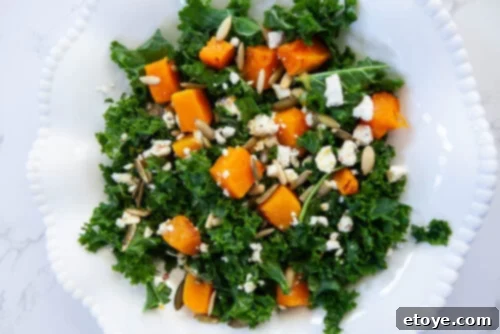
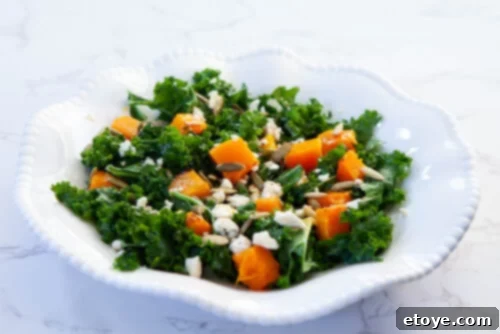

Beyond the Salad Bowl: More Recipes to Elevate Your Winter Mood
If you’re eager to explore more delicious and mood-supportive meals to help you navigate the colder months with vitality, we offer additional recipes thoughtfully designed with your overall well-being in mind. Diversifying your diet with a range of nutrient-rich dishes is an excellent strategy to keep your meals exciting and your spirits consistently high. Here are a couple of our other cherished recipes that promise to nourish and delight:
- Salmon & Creamy Spinach with Mushroom Sauce Recipe: This exquisite dish features salmon, renowned for its abundant Omega-3 fatty acids, making it another superb choice for supporting brain health and reducing inflammation.
- Healthy Turkey Stroganoff Recipe: A comforting yet lean and nutritious meal, this stroganoff provides sustained energy and warmth, perfect for chilly evenings.
Roasted Squash, Kale & Feta Salad with Walnut Vinaigrette
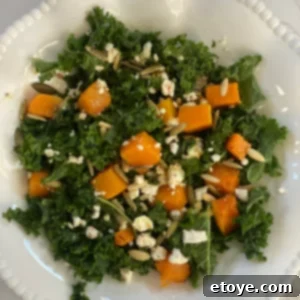
A wholesome roasted squash salad, elegantly topped with tender kale and creamy feta, exquisitely garnished with a homemade citrus walnut vinaigrette.
Rating: 5 out of 5 stars (based on 1 verified vote)
Preparation & Cooking Details
- Prep Time: 10 minutes
- Cook Time: 20 minutes
- Total Time: 30 minutes
Course & Cuisine
- Course: Appetizer, Lunch, Salad, Side Dish, Sides
- Cuisine: American
Yield & Nutritional Snapshot
- Servings: 4 people
- Calories: Approximately 490 kcal per serving
Ingredients
For the Roasted Squash, Kale & Feta Salad:
- 4 cups butternut squash, cut into 1″ cubes
- 2 tbsp extra virgin olive oil
- 2 bunches kale, leaves only, chopped
- ½ tsp kosher or sea salt
- 4 oz feta cheese, crumbled
- ¼ cup roasted pumpkin seeds
For the Citrus Walnut Vinaigrette:
- 2 tbsp sherry vinegar
- 1 orange, zested and juiced
- 1 tbsp honey
- 1 tbsp grainy mustard
- ¼ cup extra virgin olive oil
- 2 tbsp walnut oil
- 2 tbsp water
- ½ tsp kosher or sea salt
- Freshly ground black pepper, to taste
Instructions
- Preheat the oven to 450F (232°C). In a large bowl, toss the butternut squash cubes with 2 tablespoons of olive oil until evenly coated. Spread them onto a large baking sheet lined with parchment paper. Roast for 20 minutes, or until the squash is golden brown, tender, and cooked through.
- In a separate large bowl, combine the chopped kale leaves and ½ teaspoon of salt. Use your hands to gently “massage” the salt into the kale for 2-3 minutes, until the kale turns bright green and becomes silky-soft. Add the warm roasted squash, crumbled feta cheese, and roasted pumpkin seeds to the bowl with the kale.
- To prepare the vinaigrette, combine the sherry vinegar, orange zest, orange juice, honey, grainy mustard, ¼ cup extra virgin olive oil, walnut oil, water, ½ teaspoon of salt, and freshly ground black pepper in a mason jar with a tight-fitting lid. Shake vigorously until all ingredients are well combined and emulsified.
- Pour the prepared Citrus Walnut Vinaigrette over the salad ingredients in the bowl. Toss gently to ensure all components are thoroughly coated with the dressing. Serve immediately and enjoy the vibrant flavors.
Nutrition Information (Per Serving)
- Calories: 490 kcal
- Carbohydrates: 33g
- Protein: 11g
- Fat: 38g
- Saturated Fat: 8g
- Polyunsaturated Fat: 9g
- Monounsaturated Fat: 19g
- Trans Fat: 1g
- Cholesterol: 25mg
- Sodium: 991mg
- Potassium: 958mg
- Fiber: 4g
- Sugar: 12g
- Vitamin A: 21572 IU
- Vitamin C: 125mg
- Calcium: 325mg
- Iron: 3mg
Keywords
crispy kale, feta, homemade salad dressing, roasted squash, salad dressing, winter salad, mood-boosting food, seasonal affective disorder recipe, healthy salad
Tried this delightful recipe? We’d love to hear your thoughts! Let us know how it turned out in the comments below!
